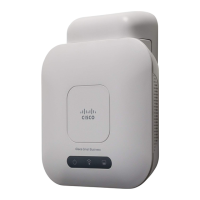Single Point Setup
Single Point Setup Overview
Cisco WAP571/E Administration Guide 170
12
Managing Single Point Setup Across Access Points
Single Point Setup creates a dynamic, configuration-aware cluster, or group, of
WAP devices in the same subnet of a network. A cluster supports a group of up to
16 configured WAP571/E devices, but no other non-WAP571/E models in the
same cluster.
Single Point Setup allows the management of more than one cluster in the same
subnet or network; however, they are managed as single independent entities.
The table shows Single Point Setup wireless service limits.
A cluster can propagate configuration information, such as VAP settings, QoS
queue parameters, and radio parameters. When you configure Single Point Setup
on a device, settings from that device (whether they are manually set or set by
default) are propagated to other devices as they join the cluster.
To form a cluster, make sure the following prerequisites or conditions are met:
STEP 1 Plan your Single Point Setup cluster. Be sure the two or more WAP devices you
want to cluster are compatible with each other. For example, Cisco WAP571/E
devices can only cluster with other Cisco WAP571/E devices.
NOTE It is strongly recommended to run the latest firmware version on all clustered
WAP devices. Firmware upgrades are not propagated to all WAP devices in a
cluster; you must upgrade each device independently.
STEP 2 Set up the WAP devices that will be clustered on the same IP subnet and verify
that they are interconnected and accessible across the switched LAN network.
STEP 3 Enable Single Point Setup on all WAP devices. See Access Points.
STEP 4 Verify that the WAP devices all reference the same Single Point Setup name. See
Access Points.
Group/Cluster
Type
WAP Devices
per Single Point
Setup
Number of
Active Clients
per Single Point
Setup
Maximum
Number of
Clients (Active
and Idle)
WAP571/E 16 960 for the
WAP571/E with a
dual radio
2048 for the
WAP571/E with a
dual radio

